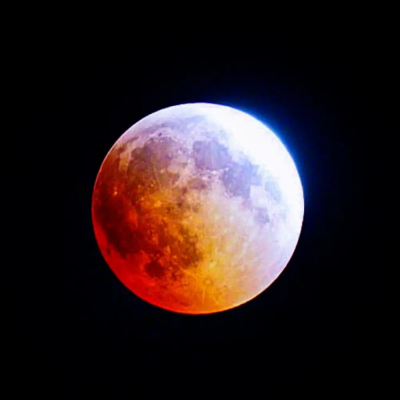The Earth will witness its first lunar eclipse of 2024 tomorrow, Monday, of the "penumbral" type, which will not be visible in the Arab region, coinciding with the timing of the full moon of Ramadan in the current Hijri year 1445. This penumbral eclipse will cover approximately 95.6% of the Moon's disk, and all its phases will last about 4 hours and 39 minutes.
This eclipse cannot be seen with the naked eye, but it can be observed through telescopes in areas where the Moon is visible at the time of the eclipse, including much of Europe, North/East Asia, a large part of Australia, North and South America, much of Africa, the Atlantic and Pacific Oceans, and the Arctic and Antarctic continents.
Solar eclipses and lunar eclipses can be used to confirm the beginnings and ends of lunar or Hijri months, as these phenomena clearly reflect the Moon's movement around the Earth and the Earth's movement around the Sun. A "penumbral" lunar eclipse occurs when the Moon passes through the Earth's penumbra, causing the Moon to become slightly darker but not completely obscured or reddened like during a total eclipse.
A lunar eclipse only happens during a full moon, when the Earth is positioned between the Sun and the Moon, casting the Earth's shadow on the Moon. Similarly, a solar eclipse—whether total, partial, or annular—only occurs when the Moon is in conjunction (new moon), meaning the Moon is positioned between the Sun and the Earth, casting its shadow on the Earth.
In this context, Jordanian astronomy expert Ali Al-Tahani stated that this year's Ramadan will witness two rare astronomical events: the lunar eclipse tomorrow and a solar eclipse on April 8. He revealed that "the penumbral lunar eclipse tomorrow will see 95% of the Moon's diameter covered by the Earth's penumbra."
Al-Tahani added that "this eclipse is not visible from Jordan or the Arab world, and the penumbral lunar eclipse will last from start to finish for 4 hours, 39 minutes, and 7 seconds." He explained that "the penumbral eclipse occurs when the Moon is full, with the Sun, Earth, and Moon aligned, where the Earth is in the middle."
He noted that "on April 8, there will be a total solar eclipse, but it will not be visible in Jordan or the Arab region as it will occur after sunset in our area, and it will only be visible in the American continent and the Pacific Ocean." He pointed out that "the eclipse is a conjunction of the Sun and Moon and the genesis of the crescent moon (Shawwal crescent), and during the eclipse, solar activity, particularly in magnetically complex areas above sunspots, will be monitored as the Moon moves above them." He disclosed that "the solar eclipse will last from start to finish for approximately 5 hours and 10 minutes."




